
www . DanYEY . co . uk
| Archive : China |
In 2015, I travelled to three historical cities in China (中国).
As usual, clicking makes the photos bigger, and more information is hidden in the captions.
Beijing (北京, Peking, Beiping, Daidu, Khanbaliq, Cambuluc), known by many exotic names, has a near-mythical status in western culture, like Rome or Timbuktu. Meanwhile contemporary Beijing brings to mind Victorian London, with deep smogs and swathes of beautiful - essentially medieval - neighbourhoods clashing with the destructive and regenerative power of industrialisation. If the right balance is struck, the city can have both - in contrast to Tokyo, which had the slate wiped clean by American bombers.
 |
|||
 |
 |
 |
 |
 |
 |
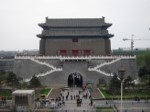 |
 |
 |
 |
 |
 |
 |
|||
 |
 |
 |
 |
 |
|||
| The Imperial Ancestral Temple (太廟, Taimiao, dating from 1420/1545) was the venue for sacrificial rites honouring the imperial ancestors several times each year. | |||
 |
 |
 |
 |
 |
|||
 |
|||
 |
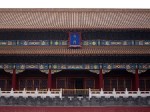 |
 |
 |
| Once past the Meridian Gate (Wumen), the visitor has formally entered The Forbidden City, so called because no commoner was permitted to enter. The 9,000-room complex occupies roughly 180 acres at the centre of Beijing, and took its present form in 1420 during the reign of the Yongle Emperor (永樂帝). Its design is attributed to Kuai Xiang, Chen Gui and others. | |||
 |
|||
 |
 |
||
 |
 |
 |
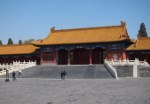 |
 |
 |
 |
 |
 |
|||
 |
|||
 |
|||
| The Hall Of Supreme Harmony (太和殿, Taihedian) is the central throne hall in the Forbidden City, where all emperors from Ming dynasty onwards were crowned. Dating from 1420 (although this iteration is from 1697), it is the largest wooden building in China and the second largest (traditional) wooden building in the world after Todai-ji in Nara. The courtyard before the hall is large enough to encircle two complete copies of Buckingham Palace. | |||
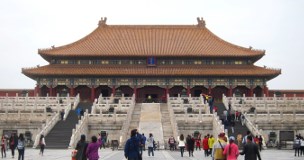 |
 |
||
 |
 |
 |
 |
 |
 |
 |
 |
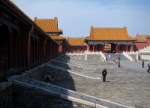 |
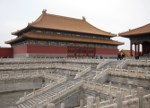 |
 |
 |
 |
 |
 |
 |
| The Hall Of Central Harmony was used as a robing room, while The Hall Of Preserving Harmony was the venue for receiving tribute from vassal states. | |||
 |
 |
 |
 |
 |
|||
 |
 |
 |
|
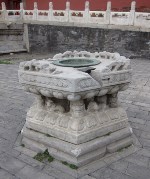 |
 |
 |
 |
| The Inner Court was the residential area of the palace. The emperor used The Palace Of Heavenly Purity, while the empress used The Palace Of Earthly Tranquility. The imperial seals were kept in The Hall Of Union. |
|||
 |
 |
 |
 |
 |
 |
 |
 |
 |
 |
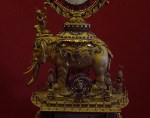 |
 |
| The Hall Of Ancestry Worship was cleared out during the madness of the Cultural Revolution (while most of the palace was unharmed). It now houses an extensive collection of European (largely British) clocks. Many were manufactured during the reign of the Qianlong Emperor (乾隆帝) by James Cox, who also created the famous Peacock Clock in St. Petersburg. Surprising, perhaps, that it was Qianlong who famously declared that the Chinese Empire had all things in abundance and no need of imports from Britain, after Lord Macartney refused to kowtow in 1793. | |||
 |
 |
 |
 |
 |
 |
 |
|
 |
 |
 |
 |
 |
 |
 |
|
 |
 |
 |
 |
 |
 |
 |
 |
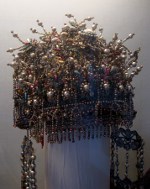 |
 |
 |
 |
 |
 |
 |
 |
 |
 |
 |
 |
 |
 |
 |
 |
 |
 |
 |
 |
 |
 |
 |
 |
 |
 |
 |
 |
 |
 |
 |
 |
 |
 |
 |
 |
 |
|||
 |
 |
 |
|
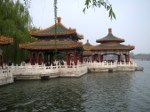 |
 |
 |
 |
| The lake of Beihai Park and the Jade Flower Island have been used as a park for around 1000 years. | |||
 |
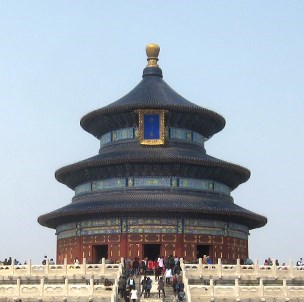 |
 |
|
 |
 |
||
 |
|||
 |
 |
 |
 |
 |
 |
 |
 |
| The Temple Of Heaven (天壇, Tiantan) was founded in 1420 by the Yongle Emperor. The emperor would pray there twice a year - once at the Hall Of Prayer For Good Harvests, and once on the Round Altar. | |||
 |
 |
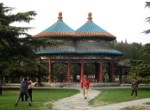 |
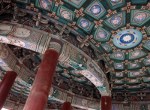 |
 |
 |
 |
 |
 |
 |
 |
 |
| The Lama Temple (雍和宮, Yonghe Temple) was begun in 1694, becoming a Tibetan Buddhist monastery in 1722. |
|||
 |
 |
 |
 |
 |
 |
 |
|
 |
 |
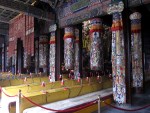 |
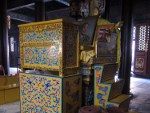 |
 |
 |
 |
 |
 |
 |
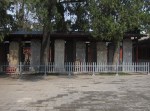 |
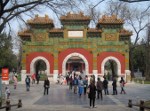 |
 |
 |
 |
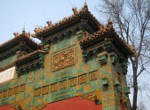 |
| The Imperial College (Guozijian) was one of the institutions where students would sit for the imperial examinations, allowing them entry into the state bureaucracy. The examination system was abolished in 1905, not long before the fall of the empire. | |||
 |
 |
 |
 |
 |
 |
 |
 |
| The ancient observatory in Beijing moved to its present site on the city wall in 1442. Although Yule provides some evidence for the instruments having been witnessed by Marco Polo in the Yuan dynasty, other sources credit Ferdinand Verbiest (a Jesuit) with their design in 1669. During the Boxer Rebellion, the French took five instruments to their embassy, while the Germans took the large armillary spheres and the celestial globe to Potsdam, returning them later in accordance with the Treaty Of Versailles. | |||
 |
 |
 |
 |
 |
 |
 |
 |
 |
 |
 |
|
| The Prince Gong mansion is a residence latterly occupied by Prince Gong, a Qing official who established China's first foreign ministry, the Zongli Yamen, during the Opium Wars. | |||
 |
 |
 |
 |
 |
 |
 |
 |
 |
 |
 |
 |
| By chance, my lodgings were on the site of the former Spanish embassy on Legation Street (Dongjiaominxiang Street), where the peace was negotiated and signed between China and the western powers after the Boxer Rebellion. Qing imperial soldiers and the Boxers had laid siege to the foreign legations for several weeks in the summer of 1900. | |||
 |
 |
 |
 |
| Xishiku Cathedral (the North Cathedral, the Peitang) was designed by the French bishop Pierre-Marie-Alphonse Favier, who was later besieged inside the cathedral with several thousand Chinese Christians during the Boxer Rebellion. | |||
 |
 |
 |
 |
| The South Cathedral was founded by Matteo Ricci in 1605, although the present building dates from 1904 after the previous one was destroyed by the Boxers.
Ricci was a Jesuit missionary from Macerata (Italy) and was the first European to enter the Forbidden City and the first to translate Confucius into Latin. |
|||
 |
 |
 |
 |
 |
 |
 |
 |
 |
 |
 |
 |
 |
 |
 |
 |
 |
 |
 |
 |
 |
 |
 |
 |
 |
 |
 |
 |
 |
 |
 |
 |
| The Yingzao Fashi (營造法式), dating from the Song dynasty, specifies the rules of Chinese architecture, much as Vitruvius and Palladio specified the classical orders in Europe. | |||
 |
 |
 |
 |
 |
 |
 |
 |
| The Yongle Emperor dispatched Zheng He (鄭和), a Muslim eunuch, on trading expeditions around the Indian Ocean, beginning in 1405. His fleet of around 300 ships, some of which were the largest in medieval history, reached the African coast and left behind artefacts such as the Galle stele in Sri Lanka. Some have speculated that Zheng He reached the Americas. | |||
 |
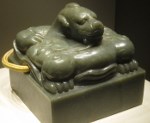 |
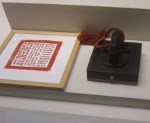 |
 |
 |
|||
| The Summer Palace, as the Garden Of Pure Ripples, was created by the Qianlong Emperor in 1750. | |||
 |
 |
 |
 |
 |
 |
 |
 |
 |
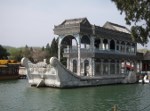 |
 |
 |
 |
 |
 |
 |
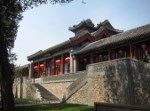 |
 |
 |
 |
 |
 |
 |
 |
 |
 |
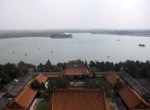 |
 |
 |
 |
 |
 |
 |
 |
 |
 |
| Yuanmingyuan Park (the Old Summer Palace) once contained a vast array of buildings like the remaining (new) Summer Palace. It included wonders such as Hanjing Hall, Anyou Palace, the Fanghu Shengjing complex, and a series of baroque buildings by Giuseppe Castiglione (from Milan), commissioned by the Qianlong Emperor in 1759. | |||
 |
 |
 |
 |
 |
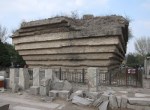 |
 |
 |
| The Summer Palace and park were destroyed by British and French troops amid the Second Opium War (1860) under the orders of Lord Elgin, in retaliation for the torture and murder of several peace envoys. Among the loot that has found its way into western museums were a number of bronze heads from the twelve animals of the Chinese zodiac that decorated the water clock of Haiyan Hall. | |||
 |
|||
| The Great Wall Of China is at least 5,000 miles long and the extant parts largely date from the Ming dynasty. |
|||
 |
 |
 |
 |
 |
 |
 |
 |
| One of thirteen Ming tombs outside Beijing, the Changling mausoleum was built for the Yongle Emperor in 1424. The emperor undertook many famous projects including the Forbidden City, the voyages of Zheng He, and an encyclopedia of more than 11,000 volumes that was largely lost when the Hanlin Academy was burned down by the Kansu Braves in 1900. | |||
 |
 |
 |
 |
| The processional way to the Changling mausoleum extends for several miles, and one section is lined with twenty-four stone creatures. | |||
 |
 |
 |
 |
 |
 |
 |
 |
 |
|||
The city of Xi'an (西安, Chang'an), in the province of Shaanxi, was the first capital of China unified by the Qin Emperor and, through various interruptions, finally ceased to be the capital at the end of the Tang dynasty. Xi'an is the eastern terminus of the Silk Road, along which China and the Roman Empire (Daqin) traded as far back as 200 BC (Han dynasty). Ambassadors from Rome are thought to have arrived in China in 166 AD.
 |
||
| The walls of Xi'an date back to the 1300s and stretch 9 miles in circumference. | ||
 |
 |
 |
 |
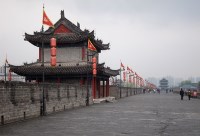 |
 |
 |
 |
 |
 |
 |
 |
 |
 |
 |
| In the shadow Xi'an's drum tower, one can find a lively street food market leading to The Great Mosque Of Xi'an, founded in 742 AD. | ||
 |
 |
 |
 |
 |
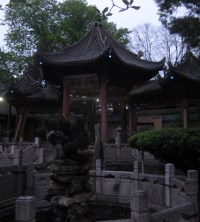 |
 |
 |
 |
 |
 |
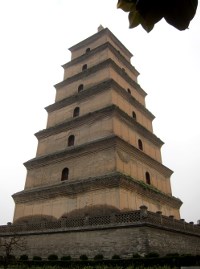 |
 |
||
| The Great Wild Goose Pagoda dates from the 7th century (Tang dynasty), and was built to hold Buddhist scriptures brought from India and translated by the monk Xuanzang (玄奘). His pilgrimage was retold in the famous novel Journey To The West. The name of the pagoda, meanwhile, is said to come from a goose that fell dead over a monastery in Magadha (India). | ||
 |
 |
 |
 |
 |
 |
 |
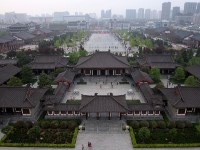 |
 |
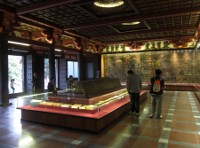 |
 |
 |
 |
 |
 |
 |
 |
 |
| The Nestorian Stele, dating from 781 AD (Tang dynasty) and rediscovered in 1625, records the earliest history of Christianity in China. The Christians in question came from the Nestorian Church, a branch of Eastern Christianity found in the Middle East. The tablet's heading includes the Chinese name for the Roman Empire - Daqin (大秦). | ||
 |
 |
 |
 |
 |
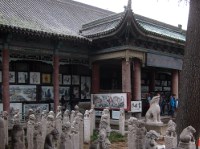 |
 |
 |
 |
 |
||
| What we know of as the Terracotta Army (some of which I had seen in San Francisco) makes up only a small part of the vast mausoleum complex of the Qin Emperor (秦始皇, Qin Shi Huang) - a staggering feat begun 200 years before Julius Caesar crossed the Rubicon. The Qin Emperor was the first to unify China, a fact fittingly reflected in the western name for the country. | ||
 |
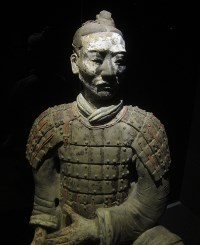 |
 |
 |
 |
 |
 |
 |
 |
Qufu (曲阜, Chufou), in the province of Shandong (2 hours from Beijing), is the town where philospher Confucius (孔丘, Kong Qiu) was born and died (in 479 BC). His teachings profoundly shaped oriental culture.












































